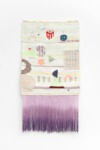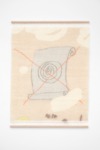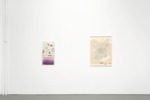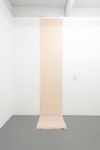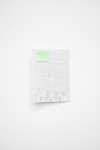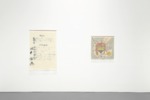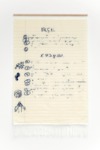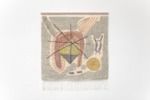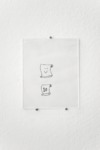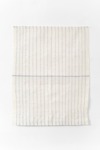Some notes on
Arna Óttarsdóttir
A Soft Power
Although the textile works and drawings by Arna Óttarsdóttir shouldn’t necessarily be
interpreted as being intentionally predefined or political, the exhibition title ‘A Soft Power’
aims to open up a number of possibilities to view her art in the light of connotations
commonly or uncommonly associated with the given term(s).
Softness.
A lack of hardness; the quality of being gentle and not loud or forceful; the quality of being
weak.¹
Not hard (changing shape easily, not stiff or firm, less hard than average),
not rough (smooth and pleasant to touch),
without angles/edges,
not too bright, in a way pleasant and relaxing to the eyes (light/colors),
not strong or violent,
not loud (usually pleasant and gentle),
sympathetic (kind and sympathetic; easily affected by others),
not strict (not strict or severe),
crazy (stupid or crazy),
not tough (wanting to be safe and comfortable).²
Power.
The ability to control or effect people or things,
[in people] the ability or opportunity to do sth / a particular ability of the body or mind / all the
abilities of a person’s body or mind,
the right or authority of a person or group to do sth,
[in compounds] the strength or influence in a particular area of activity / the influence of a
particular thing or group within society,
the strength or energy contained in sth,
a good or evil spirit that controls the lives of others.³
Soft Power.
The term soft power, first introduced in 1990 by political scientist Joseph Nye (US), is used to describe a form of power relation or a style of leadership – especially in foreign policy making and international relations – putting at its base the use of positive attraction and persuasion to achieve collaboration and/or recreation of a set example. It employs the ability to shape other peoples’ preferences and actions through appeal and attraction rather than coercion, command, or threat (Hard Power).
When asked “What is soft power?”, Nye delivers the following explanation: “Power comes in many guises, and soft power is not weakness. (…) When you can get others to admire your ideals and to want what you want, you do not have to spend as much on sticks [threats] and carrots [inducements] to move them in your direction. Seduction is always more effective than coercion.”⁴
He continues: “Soft power rests on the ability to shape preferences of others. (…) In a [personal] relationship, power does not necessarily reside with the larger partner, but in the mysterious chemistry of attraction. (…) Soft power is more than just persuasion or the ability to move people by argument, though that is an important part of it. (…) Simply put, in behavioral terms soft power is attractive power.”⁵
In order to engender cooperation, soft power calls on shared values and currencies such as attraction, admiration, justness, seduction, empathy, even love. In politics, the soft power of a nation builds on three pillars, namely culture, political values, and foreign policy.⁶ As opposed to other forms of power, it seems to have almost exclusively positive connotations, taking into account resources which might not be quantifiable or objectifiable but which are on the other hand perceptible, sensible, and, well, soft.
In this context, the soft power within the artworks of Arna Óttarsdóttir may lie in their combination of a quite literal softness (the textile, the colors, the shapes within her drawings) and a certain gentleness, unobtrusiveness, and charm radiating from them.
Although their appearance is at first glance rather feminine and delicate, the constitution of the tapestries themselves is quite powerful as the material is robust and almost imperishable.
Their shape, size and appearance on the other hand depend entirely on the good will of the artist, all the while in control of the resilient fibers.
The works mostly depict drawings, woven into tapestries taking weeks, sometimes months of labor. The act of giving these seemingly insignificant scribbles and doodles so much attention and devotion can be described as a democratic or non-hierarchical one, as any snippet from her notebook could make it into an artwork, sooner or later.
The works of Arna Óttarsdóttir do not scream for attention but quickly become objects of attraction by merely offering a subtle and discreet reclamation of authority, an invisible hand, and a benevolent narrative.
__________________
¹ Cambridge Dictionary, https://dictionary.cambridge.org/de/worterbuch/englisch/softness (04.01.2019).
² Oxford Advanced Learner’s Dictionary, 7th Edition, Oxford 2005, p. 1454.
³ Ibid. p. 1180.
⁴ Nye Jr., Joseph S.: Soft Power – The means to success in world politics. New York 2004, p. x.
⁵ Ibid. p. 5f.
⁶ The Soft Power 30 Index (an annual report aiming to „compare the relative strength of countries’ soft power resources; assessing the quality of a country’s political institutions, the extent of their cultural appeal, the strength of their diplomatic network, the global reputation of their higher education system, the attractiveness of their economic model, and a country’s digital engagement with the world.”, https://softpower30.com/what-is-soft-power/ (04.01.2019).
Lena Ipsen in conversation with Arna Óttarsdóttir
Email, Cologne – Reykjavik, December 2018
LI: Arna, I would like to really start at the beginning: When did you feel the necessity to make art?
AÓ: Art has always been a part of my life, my parents are both very creative people but both went into more practical professions. As a kid I was sent to a lot of art classes at the local art school and I used to go to so many art openings with my parents. I wanted to be an artist among other things when I was a kid but when it came to choosing a college and the classes there I started on a more traditional / safe route – I went to a pretty nice (and more creative than some) college and started studying natural sciences. I took some art classes but after one and half years I became more and more unhappy about where I was and what I was doing. I had some internet-friends / pen pals at the time who were studying art-related things and by following their lives the idea that I should do the same took hold. At that time I also got really interested in photography, I think my dad bought his first digital camera around that time? Or at least his first small one I think. So I started taking photographs and a lot of self-portraits just as a way to cope with the situation I was in, being deeply unhappy. I have never really made work that felt as urgent and necessary as the work at that time. So after two years of natural sciences I changed schools and studied art for the last two years of college.
LI: I’ve already thought that photography plays an important role for you, especially when looking at earlier works. Is there a connection between photography and your tapestries? I mean the enlarged pixels of a digital photograph, which are also apparent in collages of yours, already have the appearance of a template/design for weaving.
AÓ: Hmm. That’s hard for me to say, there’s not an obvious connection for me at least. But of course weaving is closely connected to digital imaging and even computer programming (although I have to say I’m not very knowledgeable about that aspect of it). In spite of my interest in photography and the connection between digital images and weaving, so far I’ve worked mostly with translating drawings into weaving. I work on most of the sketches for the tapestries in Photoshop and sometimes you can recognize the mark of an eraser or a brush from the software. I do like that contrast of the handmade and the digital. And of course the ‘pixel’ is very much in the nature of the medium, similar to digital photographs it depends on how fine/small the warp and weft are; how easily you can see the ‘pixels’ of the weaving... if that makes sense?
LI: Yes, that makes perfect sense. Not only do I find this contrast between the handmade and the digital – which becomes apparent in your work – very interesting but also the different aspects of time. You translate very spontaneous or revised drawing acts – like spirals and other meaningless doodles, also erasing or crossing something out – into such a time-consuming technique as weaving. I like the way you give attention to these little seemingly flawed and unimportant doodles on the margin of a notebook page. Can you say how you pick your motifs? Aren’t those fine diagonal lines and round
shapes especially complicated to weave?
AÓ: Most of the motifs come from my own sketchbooks but they’re the sort of drawings that seem maybe insignificant or unfinished; some I didn’t like at the time so there’s a big X drawn over them or I’ve written “nei nei” (“no no”) next to them. Or they’re the sort of drawings you sketch quickly to put down an idea. So they’re not drawn with the intention of being nice drawings. I also have a collection of small notes with random doodles on them, like the ones you draw when you’re talking
on the phone, on shopping lists, and so on, which are usually just thrown away.
Similar to the contrast between the handmade and the digital, I like the idea of devoting so much time and labor to these small and seemingly insignificant drawings. Also, I think most people can relate to having some anxiety about choosing things – what to do, what to buy, etc. So I think that’s also a part of the idea with using these drawings (which sometimes seem kind of random), to say that they’re all good enough and important enough, and as important as something else.
So I have this collection of scanned drawings on my computer and when I start a new work I look through that. And that selection process is pretty intuitive, some speak more to me than others and so I usually go with that gut feeling. And yes, those diagonal lines and round shapes can be a pain to weave! Shortly after I started weaving I realized drawing the image on the warp itself was easiest and then it’s not that hard to just follow those drawn lines. But I do like it when there’s a little awkwardness in the smooth rounded lines, when it happens I usually don’t go back and fix it.
LI: So, in general you don’t go back and revise very often in the process of weaving? How long does one tapestry take you to finish? I’ve imagined you working three weeks on 3 Weeks (2015) but that seems very fast, having in mind that it is 7 meters long...
AÓ: No, maybe it depends a little on the technique you use, but it’s really difficult to change anything. And if you use a regular floor loom like me you only see ca. 30 cm of the weaving at the time anyway. So really you just make a good sketch and hope for the best!
It takes me about 4-6 weeks to make a tapestry that’s 150 x 100 cm, but it depends on the motifs and the thickness of the yarn I’m using. And that’s only actually weaving; it doesn’t include doing the sketch, dyeing the yarn, dressing the loom, and so on. But 3 Weeks is just a single color (with the short yellow lines, but that doesn’t change much) so that happened super fast, you just have a weaving shuttle with one color and shoot that straight through. The method is a little different from the tapestry weaving. But at the end the work only took 3 weeks to make, the whole 7 meters.
LI: I like the idea that the medium itself sets restrictions… The preparations as well as the process of weaving seem to be very important, could you nevertheless imagine having the tapestries made elsewhere or by someone else?
AÓ: At this point, no. It’s still important to me to make the tapestries myself. As with other media, like painting, sculpting, etc., most often you can see the artist’s touch. I don’t think the tapestries would look the same if I had someone else make them. And you make so many little decisions constantly.
I’m not looking for perfection in my work and I think all the mistakes and idiosyncrasies are very much my own. I also like the idea of working with a medium that’s this slow and labor intensive, in our day and age everything is supposed to happen fast, so it’s almost like a small protest against that. I also think we have become kind of removed from the process of making things, so it’s a good reminder of the human labor that goes into making things.
LI: Let’s talk about the very specific color palette that you work with. Why do you use those colors?
AÓ: The colors came quite naturally; they are simply colors I like. In art school I drew a lot and maybe the white in them comes from the paper. I also made work that was white on white. So I think the colors started with white and emerged from there. They are soft and not aggressive, I always thought they give the eyes of the viewer a little rest… a break from the world. They are also feminine in a way, although I didn’t choose them for that but I do like the connection.
However, the colors in my works are getting more saturated now. I’ve been making red and bright pink tapestries recently. Those works definitely demand more attention. I’m not sure what brought on the change and whether it’s just a short phase. We’ll see.
LI: Is there a tendency in your recent works not only to use more saturated colors but also to enlarge the format? Are you working from home or do you have a studio?
AÓ: They have become a little larger since I started using a floor loom almost exclusively for the tapestries. When I started weaving I mainly used a wooden frame, but then I only had one open shed and the tension gets greater as you get closer to finishing, etc. It’s a really simple way to weave, which I like, but the loom feels more efficient right now. So yeah, I’ve been doing a little bigger tapestries recently but I don’t think there’s really a big difference. The biggest ones I made on the frame were 90 to 100 cm wide (and around 130 to 150 cm in length) and the maximum width on the floor loom is 120 cm.
I have a studio at home with a floor loom and I’ve also had a studio close by for about a year now. It’s pretty big but I share it with my husband. I have two looms there but the great thing about working on a loom is that the work always just takes up the space of the loom. But of course the downside is that you can’t really make bigger work than the loom allows, although you can sew parts together of course.
LI: I would love to come over for a studio visit and have a look. I immediately have those great photographs in mind of Anni Albers at the weaving workshop at Bauhaus or of her weaving studio at Black Mountain College. Not only Anni Albers but I also think of Agnes Martin. This connection seems especially strong to me because of the soft colors that you’re using and also when you talk about works that are white on white, which among others draw parallels to Martin’s series The Islands I-XII (1979). There is also this work of yours titled Dish Towel (for Agnes Martin) (2012)…
AÓ: Yes! It’s so much better to see the tapestries in real life, I don’t think they translate very well in photos. Which is probably true for most art works but I think tapestries especially. You can’t really get a feeling for the material itself, how heavy or light it is, the texture, colors, etc.
I love the works of both Anni Albers and Agnes Martin. I discovered Agnes Martin in art university and felt a connection with her because of the soft colors and the quietness of her works. Dish Towel is a small homage to her, I like that there’s this serious or grand idea/work made into a simple dishtowel.
It’s sort of the other way around from the tapestries with the drawings.
LI: Apart from these great artists, do you find yourself much in exchange with other local artists? You live and work in Reykjavík, which I imagine to be quite special. How would you describe the art scene there?
AÓ: Yeah sure, most of my friends are artists or in art related professions. The art scene here is pretty big compared to the total population but it’s not that big so you usually know quite a few people at openings and so on. The scene is pretty lively and there are always a few artist run spaces open and running at any given time, which is really great.
LI: Is the upcoming show in Berlin your first solo exhibition abroad? Are we going to see sculptural works/installations like in previous exhibitions (where a framed photograph sat on a pile of pillows, shirts were pulled over stools or cloth racks and a wig of long blond hair was arranged on a wooden construction)? Do you still work in this manner or does it depend on the exhibition space?
AÓ: Yes, it is my first solo show abroad. When Katharina invited me, she suggested to show some early tapestry works which I have only shown once before, at i8 Gallery in Reykjavik in 2015. So the exhibition at Åplus is going to have a closer resemblance to that show. There will only be tapestries, but we might include a few drawings as well. It’ll become clearer when we start installing.
I still make sculptural works and installations as well though; I’m actually working on another solo exhibition which will open in Reykjavík in March. There will be a wider range of works there. I guess it depends on the exhibition space and curator. And also just at which time the exhibition is made – what I’m making at the time.
__________________
Arna Óttarsdóttir (born 1986 in Iceland, lives and works in Reykjavik) studied natural sciences before switching to the Fine Art program at the Iceland Academy of the Arts (2006-2009). Solo exhibitions include i8 Gallery, Reykjavik, Harbinger, Reykjavik, and Kunstschlager, Reykjavik; group exhibitions include Nordatlantens Brygge, Copenhagen, the Reykjavik Art Museum, the Reykjavik Arts Festival, King Size, Leipzig, Hemliga Trädgården, Stockholm, The Willows, New York, Sound of Mu, Oslo, The Akureyri Art Museum, Galleri 69, Oslo, and Galerie Sign, Groningen. ‘A Soft Power’ is her first solo exhibition outside of Iceland.
Lena Ipsen (born 1989 in Cuxhaven, lives and works in Cologne) is an art historian and curator. She was an assistant for various artists and galleries before starting to work for The Estate of Martin Kippenberger, Galerie Gisela Capitain, Cologne in 2016. She studied Visual Arts, Music and Media at Philipps-Universität Marburg as well as Art and Visual History at Humboldt-Universität zu Berlin and at Sapienza – Università di Roma. Curated exhibitions include ‘How to Charm’, QBox Gallery, Athens (2016), ‚L‘avventura/Die mit der Liebe spielen’, Palazzo Guaineri delle Cossere, Brescia (2015) and ‘Frauen – Die Ausstellung’, Autocenter, Berlin (2014).
__in conversation with__ is an exhibition format aiming at bringing people together through conversation and subsequent collaboration. Artists are invited to engage in dialogue with curators, authors, other artists, art historians, journalists or scientists and to develop an exhibition from it. The conversations are documented in writing, serving as text material accompanying the exhibition. They enable visitors to develop a deeper understanding of the artists’ methods and of the artworks. __in conversation with__ is based on the premise that it is the artists themselves who can best provide information about their works, their methods, their ideas and inspirations. One simply needs to ask.
__in conversation with__ was initiated in early 2018 by Katharina Wendler in Berlin and is guest of various (project) spaces.
© 2019 Lena Ipsen / Arna Óttarsdóttir
courtesy the artist and i8 Gallery, Reykjavik


